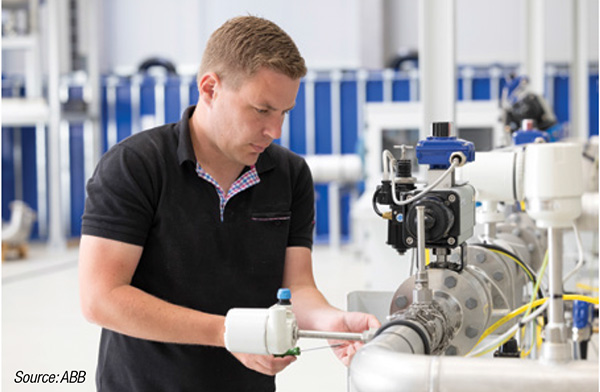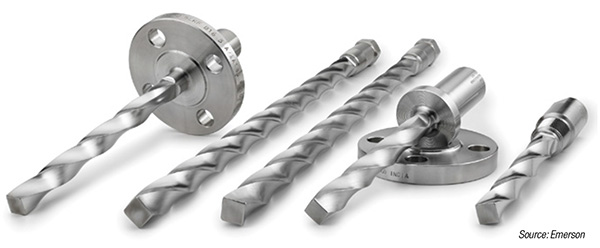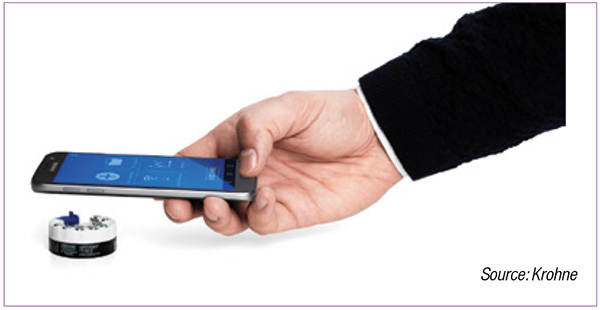Enhanced measurement capabilities offer more reliable control to boost quality, reduce waste and ensure safety
As optimization, sustainability and safety initiatives continue to be a driving force in the chemical process industries (CPI), accurate, responsive and reliable temperature measurements are more critical than ever. Realizing the challenges associated with obtaining these measurement goals in the extreme environments present in many chemical processes, instrumentation providers are developing innovative temperature measurement devices that help optimize processes and product quality, reduce waste and enhance safety in chemical applications.
Temperature measurement and control are crucial in chemical processing for several reasons, according to Guru Sosale, global product manager, temperature and non-invasive technologies, ABB Measurement & Analytics (Zurich, Switzerland; abb.com).
“First and foremost, is safety and hazard prevention,” says Sosale. “Many chemical reactions are exothermic or endothermic so uncontrolled temperatures can lead to runaway reactions, fires or explosions. And, as many industrial processes are subject to strict environmental and safety regulations, accurate temperature control helps meet industry standards and avoid legal penalties.”
Temperature measurement also plays a major role in optimization and sustainability. “Precise temperature control ensures that chemical reactions occur under optimal conditions, leading to consistent product quality and preventing unwanted byproducts,” he adds. “And maintaining the correct temperature helps optimize reaction rates, reducing energy consumption and minimizing raw-material waste. Further, proper temperature regulation prevents overheating, thermal stress and corrosion in processing equipment, thereby extending its lifespan and reducing maintenance costs.”
Mikayla Nitoski, temperature product manager, Yokogawa (Tokyo, Japan; yokogawa.com), agrees: “Process safety and efficiency are basic but important factors that can be controlled by temperature and other measurements,” says Nitoski. “Temperature in a process can affect the quality of product produced, as well as impacting the energy consumption and process optimization, leading to an increase or decrease in efficiency for the plant. Further, uncontrolled temperature changes can lead to safety risks, such as explosions and the release of hazardous chemicals.”
Measurement challenges
While temperature measurement and control are critical measurements, they are also challenging ones, according to the experts. “Many chemical processes involve extreme temperatures, high pressures and corrosive or abrasive substances. These conditions can degrade sensors and instruments, leading to inaccurate readings and frequent maintenance,” explains ABB’s Sosale.
Additionally, complex chemical reactions present a challenge. “Some reactions are highly sensitive to temperature fluctuations and require precise and rapid adjustments,” he says. “Small deviations can lead to unwanted byproducts, reduced yield or dangerous runaway reactions.”
And, sensor placement and accessibility may make accurate temperature measurement difficult in chemical facilities. “In large-scale chemical plants, measuring temperature at critical points can be difficult due to equipment design, insulation and hazardous environments,” says Sosale. “Ensuring accurate readings without interrupting operations can be a major challenge.”
In spite of these challenges, Yokogawa’s Nitoski says instruments must be accurate and repeatable to ensure the chemical and mixtures do not exceed temperature limitations, reliable enough to handle harsh conditions and maintain a long lifecycle, responsive to measure temperature swings and spikes and stable over extended periods to ensure high efficiency and reduced downtime. “Instrumentation should also include predictive maintenance, such as health checks with advanced diagnostics, while providing ease of use to reduce operational costs,” notes Nitoski.
Greg Pryor, temperature product marketing manager at Endress+Hauser USA (Greenwood, Ind.; us.endress.com) adds: “The harsher the process and the higher the temperatures, the more limited measurement device choices become, highlighting the importance of specifying the right assembly for the application.”

FIGURE 2. The TTH300-N is the transmitter power behind ABB’s TSP431-N NINVA non-invasive temperature sensor with a SIL-2 certification. Non-invasive measurement is safer to use and simpler to install and can lower the cost of installation, while reducing maintenance and inspection costs
New instrument developments
Fortunately, there are new developments in temperature instrumentation that help overcome these challenges. “The basics of how thermocouples and RTDs [resistance temperature detectors] work have not changed, but we are constantly finding new ways to enhance their capabilities,” says Pryor. “For example, vibration-resistant RTDs prevent element breakage, dramatically increasing sensor lifespan. Additionally, faster response time designs allow for tighter windows on relays for control points. Finally, non-invasive measurement is becoming increasingly common due to challenging process conditions.”
He continues to say that there is increasing demand for non-invasive temperature instruments that do not require penetration into the pipe or vessel in the chemical industry. Endress+Hauser’s iTHERM SurfaceLine TM611 (Figure 1) provides non-invasive measurement that is suitable for demanding process conditions, such as high flow velocities, high process pressures, viscous or corrosive media, abrasion, pigging or small pipe diameters. “Frequently replacing exotic-alloy thermowells can be expensive, so having an assembly that does not contact the actual process medium provides considerable cost savings over a short span,” notes Pryor. “This instrument is also ideal for device replacement in existing facilities because installation does not require shutting down the process, and it provides energy and safety monitoring diagnostics.”

FIGURE 1. Endress+Hauser’s iTHERM SurfaceLine TM611 is a noninvasive surface thermometer with energy and safety monitoring diagnostics. It is well suited for temperature measurement in demanding processes, including high flow velocities, high process pressures, small pipe diameters and harsh mediums
Roger Morrison, global product manager, Emerson (Shakopee, Minn.; emerson.com) agrees: “There are more extremes in chemical processes these days and those variables must be measured by instruments that can survive in those environments. Therefore, the ability to use non-intrusive temperature measurement using a pipe clamp or direct measurement from the outside of the pipe with an accurate and reliable process temperature output eliminates a lot of the concerns in environments that would deteriorate a thermowell.”
In addition, non-intrusive instruments provide flexibility and simplicity. “They are a nimbler solution because they can be moved around the plant for a variety of applications, can be used as a retrofit or later-state design change solution and are easier and faster to install than more intrusive instruments,” says Morrison.
Emerson’s Rosemount X-well Technology accurately measures internal process temperature without a thermowell or process penetration, allowing users to safely record process temperature with a non-intrusive solution. The technology measures the ambient and pipe surface temperatures to calculate process temperature via a thermal conductivity algorithm. This calculation takes into account the thermal conductive properties of the assembly and pipe for reliable and accurate process temperature measurements, similar to the accuracy of traditional thermowells.
ABB also offers a non-invasive solution. The TTH300-N is the transmitter power behind TSP431-N NINVA (Figure 2), which is a non-invasive temperature sensor with a safety integrity level (SIL)-2 certification. “Our non-invasive approach has been tried, tested and is being used by customers globally,” says Sosale. “This type of measurement is not only inherently safer to use and simpler to install, but it can reduce the overall cost of installation by up to 75% compared to traditional approaches, while reducing the lifecycle costs of maintenance and inspection.

FIGURE 2. The TTH300-N is the transmitter power behind ABB’s TSP431-N NINVA non-invasive temperature sensor with a SIL-2 certification. Non-invasive measurement is safer to use and simpler to install and can lower the cost of installation, while reducing maintenance and inspection costs
“In addition, by using the pipe as the body in contact with the fluid, both the accuracy and response of the system can easily be modeled by tools, giving a complete paradigm shift in determining if the measurement will meet the safety and control requirements and how to tune the system given the defined response,” he says.
In addition to using non-invasive instruments in plants where temperature measurement is added after the fact because it is faster and less costly approach, ABB’s non-invasive approach is also being used in applications aimed at sustainability and safety, such as heat exchanger monitoring and control, steam and energy measurement, measurement of the effectiveness of heat tracing and high-temperature/high-flowrate gas measurements.
And for challenging applications where non-invasive measurement is not desired, instrument providers are devising other technologies. For example, Emerson’s Twisted Square thermowell (Figure 3) achieves accurate process temperature measurement and reduces the risk of thermowell failure in challenging environments, says Don Fregelette, vice president of global chemical industry with Emerson. It eliminates over 90% of dynamic stress, the primary source of thermowell fatigue failures, and provides a great solution for conventional thermowells that do not pass ASME PTC 19.3 TW evaluations.

FIGURE 3. Emerson’s Twisted Square thermowell achieves accurate process temperature measurement and reduces the risk of thermowell failure in challenging environments because it eliminates over 90% of dynamic stress, the primary source of thermowell fatigue failures
“It is especially helpful in applications that have vibration because it is more reliable than applying non-invasive technologies in cases where there is thicker pipe stock that may cause a loss of dynamics or speed of measurement,” says Fregelette. “It is also specified in dynamic applications where the wake frequency calculations indicate that traditional thermowells would fail, so it’s an alternative to a lot of situations.”
Endress+Hauser has also a solution for challenging applications with vibration. “In cases where dynamic forces make the thermowell vibrate, you need a strong sensor in the thermowell to extend the lifespan, so we devised iTHERM StrongSens to offer long-term stable and reliable measurement values, even with highest vibrations present, for example in turbines and compressors, or in utilities where process streams run with high speed,” says Michele Pietroni, industry manager for temperature and system products, oil, gas and chemical industries, with Endress+Hauser Temperature+Systems Products (Pessano, Italy; ehts.endress.com).
“The robustness of the sensor comes from its design, where the Pt100 thin-film sensor is fixed into a special type of concrete. This enables long-term stability and reliable measurement values under intensive sensor accelerations into the thermowell, up to 60 g,” Pietroni continues.
To further increase reliability of measurements to ensure safety, accuracy and reliable operation in chemical processes, instrument providers are developing functional technology additions for their devices, as well.
For instance, Lothar Gellrich, vice president of marketing and specialist for functional safety with Krohne (Duisburg, Germany; krohne.de), says that to maintain initial accuracy in the long term, temperature sensors require frequent recalibration. “However, this is a time-consuming effort. The sensors need to be removed from the process and dismantling and re-installing may also damage them, affecting process safety,” Gellrich says. “But Krohne’s OptiTemp temperature sensors with in-situ calibration functionality allow for calibration under process conditions using a calibrated reference sensor that is plugged into the installed sensor on site to determine the measurement deviation. This makes calibration more efficient and accurate while minimizing the risk of sensor errors and damage.”
Diagnostics and condition monitoring are also functional additions that help to boost reliability of both measurement and instrumentation. Gellrich points to OptiTemp temperature transmitters with SmartSense, a technology that monitors the temperature assembly and warns for isolation errors due to humidity in the thermowell caused by wear, corrosion or cracks.
SmartSense offers the possibility of monitoring a Pt100 (three-wire connected) or thermocouple sensor with a low isolation resistance. SmartSense not only monitors the sensor but also the conductors from the sensor terminals to the transmitter terminals, giving full control over the condition of the measuring chain from the measuring point to the transmitter. “This ensures reliability, which is essential for process optimization, but also for process safety as an incorrect temperature measurement can directly cause a critical condition in the process,” says Gellrich.
Additionally, says Gellrich, OptiTemp temperature transmitters with near field communication (NFC) (Figure 4) allow wireless programming via smartphone and mobile applications. A selected configuration can be carried out on many other transmitters in just a few seconds without time-consuming, error-prone procedures, ensuring process safety via reliable configuration of temperature transmitters.

FIGURE 4. Krohne’s OptiTemp temperature transmitters with near field communication (NFC) allow wireless programming via smartphone and mobile app. A selected configuration can be carried out on many other transmitters in just a few seconds without time-consuming, error-prone procedures
Yokogawa’s Nitoski adds that the industry is trending toward the use of wireless sensors that allow for more predictive maintenance monitoring. “These new technologies can be used to provide improved accuracy and reliability,” she says. “With the improvement of response time due to these additional measurement points, users can plan maintenance downtimes using predictive maintenance features.”
Yokogawa’s YTA710 temperature transmitter, for example, offers advanced diagnostics for the temperature sensor and its electrical cable. The diagnostic information aims to reduce plant downtime by providing predictive maintenance information and backup sensor preparation in advance (Figure 5).

FIGURE 5. As the industry trends toward using more wireless sensors, Yokogawa’s YTA710 temperature transmitter offers advanced diagnostics to reduce plant downtime by providing predictive maintenance information and backup sensor preparation in advance
Further, the transmitter has the capability of having two sensors supply input to the unit, with one serving as the primary sensor and the other as the secondary sensor. The transmitter can be set up to automatically switch to the secondary sensor if the primary sensor fails. When this occurs, an alarm message is generated on the transmitter display and transmitted to the host system and asset manager. The failed sensor can be replaced during the next maintenance period, avoiding unscheduled plant shutdowns and any adverse impact to plant control due to a faulty temperature sensor.
And whether the goal is safety, process optimization or sustainability, fast response time is essential. So, Endress+Hauser introduced its iTHERM ModuLine TM 131 with QuickSens, which is a Pt100 thin-film sensor offering short response times (t90 = 1.5 s) to deliver precise, fast and stable temperature measurement to better enable process quality and reliable product quality.
“It is growing more important to have a robust instrument with high accuracy and fast response time. However, this is often difficult because the mass of the thermowell must be robust enough to protect the sensor, so we have developed sensors with technologies which fit with different thermowell designs to achieve the best compromise between fast response time and accuracy in a robust instrument with a long life,” explains Pietroni.
“There is no one-size-fits-all solution for measuring temperature, so identifying the correct assembly and configuration for each application is critical,” concludes Endress+Hauser’s Pryor. “But processors must have confidence in the readings from their temperature sensors to monitor and control the processes more effectively, so we are working on developing technologies that provide accuracy and reliability, enabling better safety and quality in the chemical processing industry.”
Joy LePree